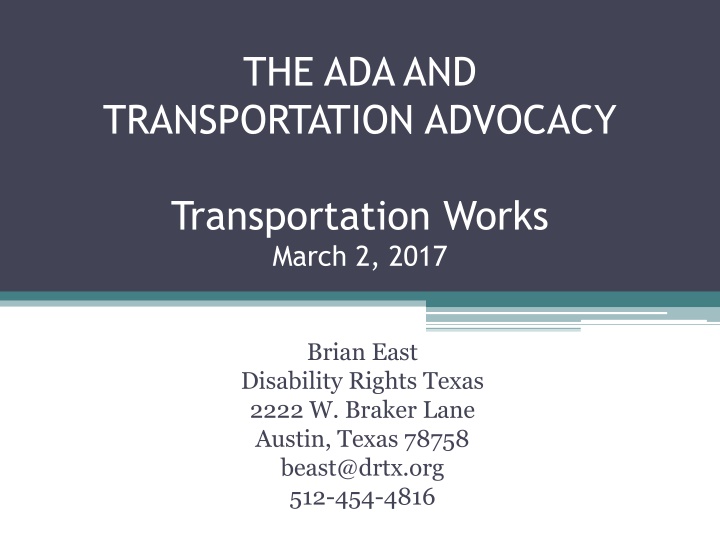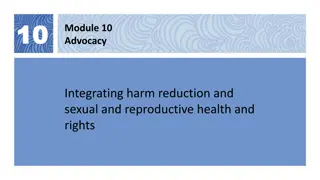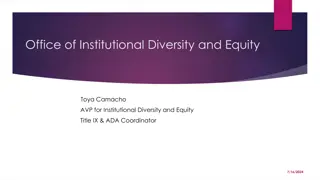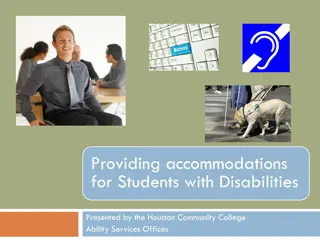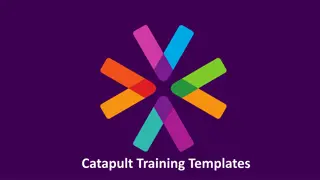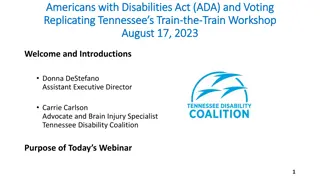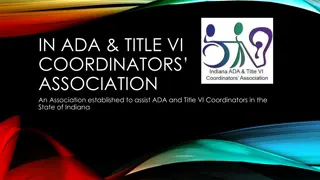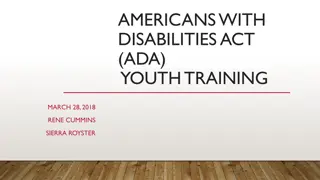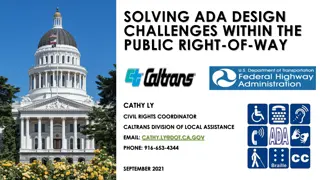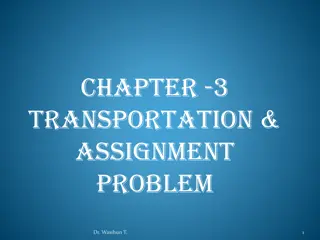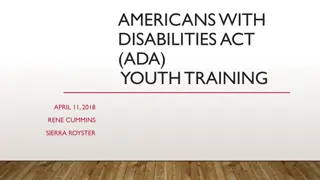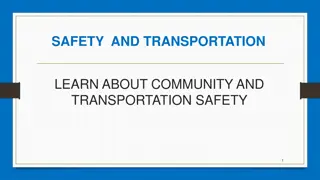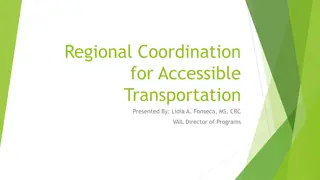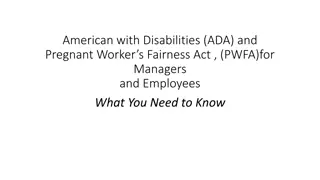Overview of ADA and Transportation Advocacy
The ADA addresses discrimination in various areas, including employment, public entities, public accommodations, telecommunications, and transportation. It covers aspects like sidewalks, taxis, ride-share services, city buses, over-the-road buses, and trains. While the ADA has limited involvement in air travel, it mainly focuses on government-run areas of airports. Specific requirements and specifications apply to different modes of transportation to ensure accessibility and equal service for individuals with disabilities.
Uploaded on Oct 05, 2024 | 0 Views
Download Presentation

Please find below an Image/Link to download the presentation.
The content on the website is provided AS IS for your information and personal use only. It may not be sold, licensed, or shared on other websites without obtaining consent from the author.If you encounter any issues during the download, it is possible that the publisher has removed the file from their server.
You are allowed to download the files provided on this website for personal or commercial use, subject to the condition that they are used lawfully. All files are the property of their respective owners.
The content on the website is provided AS IS for your information and personal use only. It may not be sold, licensed, or shared on other websites without obtaining consent from the author.
E N D
Presentation Transcript
THE ADA AND TRANSPORTATION ADVOCACY Transportation Works March 2, 2017 Brian East Disability Rights Texas 2222 W. Braker Lane Austin, Texas 78758 beast@drtx.org 512-454-4816
Scope ADA Covers Discrimination In: Employment (Title I) Public (i.e., governmental) entities (Title II, Division A) Public accommodations (private businesses) (Title III ) Telecommunications (Title IV) Transportation (Title II Div. B, and parts of Title III)
Some Kinds of Transportation the ADA Addresses Sidewalks Taxis Ride-Share City Buses Over-The-Road Buses Trains
Air Travel? The ADA only plays a limited role basically it covers the parts of an airport (and the airport s public transportation system) that are run by the government The planes themselves, and private terminals, are covered by different laws, most notably the Air Carriers Access Act (ACAA) ACAA remedies very limited
Sidewalks Title II covers sidewalks Sidewalks built or altered after 1/27/92 must have curb ramps and follow specs For streets resurfaced or otherwise altered after 1//27/92, adjacent sidewalks must have curb ramps that follow technical specs There is a program access standard for older streets & sidewalks, but it is more case-by-case Statute of limitations is 2 years, & begins when the person encounters bad sidewalk What if there are no sidewalks?
Taxis Unless company offers equivalent service, vehicles must be accessible if bought or leased: after 8/25/90, and can carry 8 or more (incl. driver) after 2/25/92, and is a van that can carry <8 Accessibility specs are in 49 C.F.R. Part 38 (and include, e.g., lifts, etc.) Sedans do not have to be accessible Equivalent service looks at both integrated setting and equality of response time, fares, service area, hours, reservations, information access, service availability, and any limits on trip purpose
Ride-Share or Transportation Network Companies Cases and DOJ say ride-share companies are covered by the transportation provisions (and perhaps others) in Title III Cases so far include claims involving: Accepting service animals Accessibility of apps Offering assistance to blind riders Accepting wheelchairs & other mobility aids
Private Courtesy Shuttles Re private company not primarily engaged in transportation, e.g., airline, hotel, or rental-car courtesy shuttle service Accessible vehicle if: Fixed-route and capacity > 16 Fixed-route and capacity 16 or fewer, unless system as a whole offers equivalent service per 37.105 Demand-responsive and > 16, unless system as a whole offers equivalent service per 37.105 Demand-responsive and 16 or fewer, system as a whole must offer equivalent service per 37.105 See above re equivalent service
Recap of Accessible-Vehicle Requirements An accessible vehicle means a vehicle that complies with 49 C.F.R. 37.7 and Part 38 Whether new vehicles must be accessible depends on whether service provider is: A private or a public entity Primarily engaged in the business of transportation or not Operating a demand-response or a fixed- route system
City Buses Fixed-route ( mainline ) vs. paratransit If bus system is public entity, or a private company contracting with a public entity, vehicles purchased or leased after 8/25/90 must be accessible (mainline & paratransit) Stop announcements (live or recorded), per 49 C.F.R. 37.167 DOT regs (incl. accessibility and service standards) are at 49 C.F.R. Parts 37 and 38 What if no bus system at all?
City BusesFixed-Route Can t deny services, even if it: takes the individual longer or is more difficult supposedly offends, inconveniences, or annoys employees or others Can t force person into priority seats Can t charge more Can t require an attendant Can t use lack of insurance to deny service Can t use non-employees to assist (unless person with disability requests)
Maintenance of Accessibility Features Prompt repairs of accessibility features req d Must offer accommodations if problems Isolated or temporary interruptions for repairs/maintenance usually discrimination Pattern of interruptions or overly long interruptions could = discrimination If lift or ramp is inoperative, vehicle generally goes out of service and another bus sent, or entity provides prompt alternative service
City BusesParatransit If entity operates fixed-route (mainline) system, it must operate a complementary paratransit system. 49 C.F.R. 37.121(a) Paratransit is for people who can t use fixed- route bus or rail service Service must be provided within -mile of bus route or rail station Must operate same hours and days Fare can t be > double that of fixed-route Reservation service must be open same hours that administrative offices are open
Paratransit Issues Eligibility and appeals Companions one may ride; others if space Attendants entity can t force; rides free; does not count as companion; need not pre-register Reservations one-day notice enough; must give slot w/in 1 hour of requested slot On-time performance pickup window shouldn t be > 30 mins; avoid very early and late pickups; may have max wait time but doesn t begin until start of pickup window ; drop-off not > 30 mins early; trip not too long (compared to mainline)
Paratransit Issues (contd) Origin-to-destination service door-to-door or curb-to curb, but entity s choice can be modified Procedures for suspending service to rider for pattern of missed trips (w/in rider s control), or violent or illegal conduct; right to a hearing Public input into paratransit plan and policy changes
Reasonable Accommodations Does the ADA require transit providers to consider policy modifications that a rider needs? Courts originally said no Melton v. Dallas Area Rapid Transit, 391 F.3d 669 (5th Cir. 2004) DOT changed regs in 2015 to require. 49 C.F.R. 37.5(i)(3) and 37.169(c)(1)-(3), and App. E. Examples: bus driver helping with fare collection or pulling slightly past obstructed bus stop; paratransit driver changing pickup locations, or assisting in extreme weather Applies to policies/practices, not the regs; e.g., can t expand -mile paratransit area
Defenses to Accommodations Fundamental alteration of service (e.g., requests for specific vehicle, exclusive rides, help carrying packages, operating outside of service hours) Direct threat to the health or safety of others (exposing vehicle to hazards, leaving vehicle unattended for a long time) Not needed by the requester to use the service (even without modification, rider is fully able to use services, e.g., requesting a specific driver) Undue financial/administrative burden (depends on details, burden of proof on entity, e.g., asking not ride with particular passenger)
No Transportation Services At All? Public transportation grants (e.g., FTA s Sec. 5307 Urbanized Area Formula Grants or Sec. 5311 Formula Grants for Rural Areas)? Voucher Programs? Other?
Intercity Buses (OTRB) OTRB fixed-route vehicles must be accessible (incl. lift, tie-downs, etc.) Small companies (<$9.6 million) must have accessible vehicles or equivalent service Access to intermediate stops & rest stops Greyhound settlement maintaining accessibility features, providing boarding help, allowing exiting at rest stops; online reservations for people using wheelchairs
Light Rail & Trains Transit facilities, intermodal centers, rail stations, and platforms must meet accessibility standards Level boarding: train doorways and station platforms must be on same level, and gaps narrow enough for wheelchair user to roll across (or use short bridge plate) AMTRAK station problems DOJ Letter of Finding in 2015
State Laws? Hum. Res. Code 121.002(5) defines public facility to include streets, sidewalks, and any public conveyance or mode of transportation 121.003(a) same right to full use and enjoyment 121.003(b) no public conveyance or mode of transportation may refuse to accept passenger because of disability, and can t charge more because of service animal, wheelchair, crutches, or other device used to assist in travel 121.003(c) can t be denied admittance to public facility because of disability or because of use of cane, assistance animal, wheelchair, crutches, or other device of assistance 121.003(d) discrimination includes failure to (1) comply with TAS, (2) make reasonable policy modifications, or (3) provide necessary auxiliary aids and services
RemediesSidewalks, Taxis, Ride-Share, Amtrak Administrative complaints File with DOJ within 180 days Can be filed online, or via mail or fax Info about the Department of Justice s complaint process: https://www.ada.gov/filing_complaint.htm Lawsuits File within 2 years of encountering barrier Remedies include court order, attorney fees, costs, and (in some cases) damages
RemediesCity Buses, Light Rail Administrative Complaints File within 180 days with FTA via mail Info about the Federal Transit Administration s complaint process is online at: https://www.transit.dot.gov/regulations-and- guidance/civil-rights-ada/file-complaint-fta Lawsuits
RemediesOTRBs Administrative Complaints Online complaints through National Consumer Complaint Database, https://nccdb.fmcsa.dot.gov/nccdb/ComplaintE ntry.aspx?choice=CONSUMER# Phone complaints: 888/368-7238 (weekdays 9 7 EST) Lawsuits
RemediesAir Travel Administrative Complaints Most carriers must have Complaints Resolution Official (CRO) available at all times airline is operating at any airport (phone or in-person) DOT toll-free number: 800/778-4838 (voice) or 800/455-9880 (TTY) DOT complaint process (limited remedies): https://www.transportation.gov/airconsumer/c omplaints-alleging-discriminatory-treatment- against-disabled-travelers Lawsuits may not be available
State Law Remedies No administrative enforcement mechanism Can bring private lawsuit for money damages, which are no less than $300. Can also probably get injunctive relief (i.e., an order from the court to fix the problem), but there is little case law It is unclear whether you can sue a governmental entity under Hum. Res. Code Chapter 121 Cannot recover attorney s fees
Sample Resources DRTX handout re paratransit eligibility: http://www.disabilityrightstx.org/files/What-Is-Paratransit- Service-and-How-Can-I-Get-It_aug2013.pdf FTA Q&A re Wheelchairs and Bus and Rail Service: https://www.transit.dot.gov/regulations-and-guidance/civil- rights-ada/questions-and-answers-concerning-wheelchairs- and-bus-and Guide: Air Travelers with Developmental Disabilities https://cms.dot.gov/sites/dot.gov/files/docs/Developmental _Disabilities_Guide_0.pdf Project Action s Accessibility Checklist for Transportation and Mobility: http://www.nadtc.org/wp- content/uploads/NADTC-Checklist-for-Assessing-the- Accessibility-of-Transportation-and-Mobility.pdf
Brian East Disability Rights Texas 2222 West Braker Lane Austin, Texas 78758 512/454-4816 beast@drtx.org
